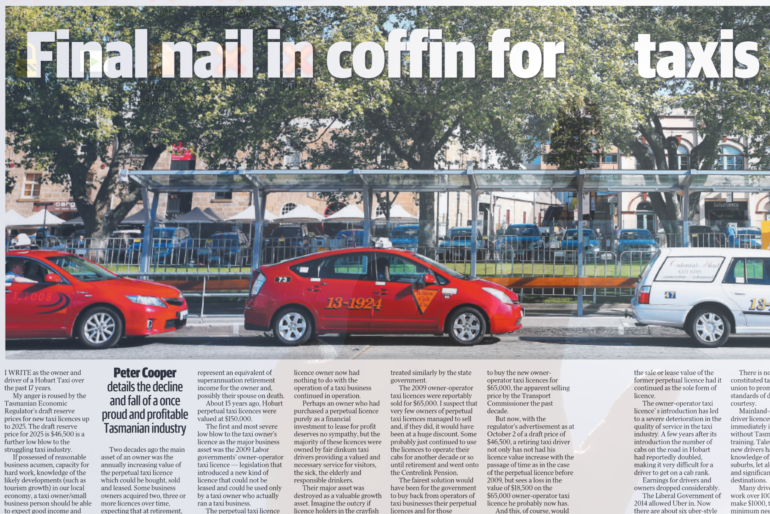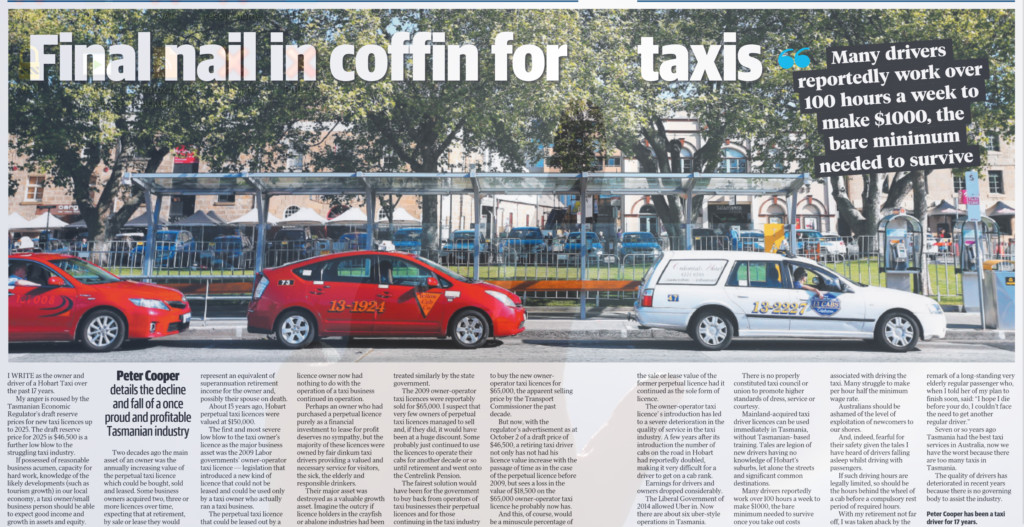
CGHB Board Member Peter Cooper details the decline and fall of a once proud and profitable Tasmanian industry in the Mercury Thursday on 27th October

I WRITE as the owner and driver of a Hobart Taxi over the past 17 years. My anger is roused by the Tasmanian Economic Regulator’s draft reserve prices for new taxi licences up to The draft reserve price for 2025 is $46,500 is a further low blow to the struggling taxi industry.
If possessed of reasonable business acumen, capacity for hard work, knowledge of the likely developments (such as tourism growth) in our local economy, a taxi owner/small business person should be able to expect good income and growth in assets and equity.
Two decades ago the main asset of an owner was the annually increasing value of the perpetual taxi licence which could be bought, sold and leased. Some business owners acquired two, three or more licences over time, expecting that at retirement, by sale or lease they would represent an equivalent of superannuation retirement income for the owner and, possibly their spouse on death.
About 15 years ago, Hobart perpetual taxi licences were valued at $150,000.
The first and most severe low blow to the taxi owner’s licence as the major business asset was the 2009 Labor governments’ owner-operator taxi licence — legislation that introduced a new kind of licence that could not be leased and could be used only by a taxi owner who actually ran a taxi business.
The perpetual taxi licence that could be leased out by a licence owner now had nothing to do with the operation of a taxi business continued in operation.
Perhaps an owner who had purchased a perpetual licence purely as a financial investment to lease for profit deserves no sympathy, but the majority of these licences were owned by fair dinkum taxi drivers providing a valued and necessary service for visitors, the sick, the elderly and responsible drinkers.
Their major asset was destroyed as a valuable growth asset. Imagine the outcry if licence holders in the crayfish or abalone industries had been treated similarly by the state government.
The 2009 owner-operator taxi licences were reportably sold for $65,000. I suspect that very few owners of perpetual taxi licences managed to sell and, if they did, it would have been at a huge discount. Some probably just continued to use the licences to operate their cabs for another decade or so until retirement and went onto the Centrelink Pension.
The fairest solution would have been for the government to buy back from operators of taxi businesses their perpetual licences and for those continuing in the taxi industry to buy the new owneroperator taxi licences for $65,000, the apparent selling price by the Transport Commissioner the past decade.
But now, with the regulator’s advertisement as at October 2 of a draft price of $46,500, a retiring taxi driver not only has not had his licence value increase with the passage of time as in the case of the perpetual licence before 2009, but sees a loss in the value of $18,500 on the $65,000 owner-operator taxi licence he probably now has.
And this, of course, would be a minuscule percentage of the sale or lease value of the former perpetual licence had it continued as the sole form of licence.
The owner-operator taxi licence’ s introduction has led to a severe deterioration in the quality of service in the taxi industry. A few years after its introduction the number of cabs on the road in Hobart had reportedly doubled, making it very difficult for a driver to get on a cab rank.
Earnings for drivers and owners dropped considerably. The Liberal Government of 2014 allowed Uber in. Now there are about six uber-style operations in Tasmania. There is no properly constituted taxi council or union to promote higher standards of dress, service or courtesy.
Mainland-acquired taxi driver licences can be used immediately in Tasmania, without Tasmanian- based training. Tales are legion of new drivers having no knowledge of Hobart’s suburbs, let alone the streets and significant common destinations.
Many drivers reportedly work over 100 hours a week to make $1000, the bare minimum needed to survive once you take out costs associated with driving the taxi. Many struggle to make per hour half the minimum wage rate.
Australians should be ashamed of the level of exploitation of newcomers to our shores.
And, indeed, fearful for their safety given the tales I have heard of drivers falling asleep whilst driving with passengers.
If such driving hours are legally limited, so should be the hours behind the wheel of a cab before a compulsory rest period of required hours.
With my retirement not far off, I was taken aback by the remark of a long-standing very elderly regular passenger who, when I told her of my plan to finish soon, said: “I hope I die before your do, I couldn’t face the need to get another regular driver.”
Seven or so years ago Tasmania had the best taxi services in Australia, now we have the worst because there are too many taxis in Tasmania.
The quality of drivers has deteriorated in recent years because there is no governing body to assist the industry.
Peter Cooper has been a taxi driver for 17 years.

Mercury Thursday 27 October

